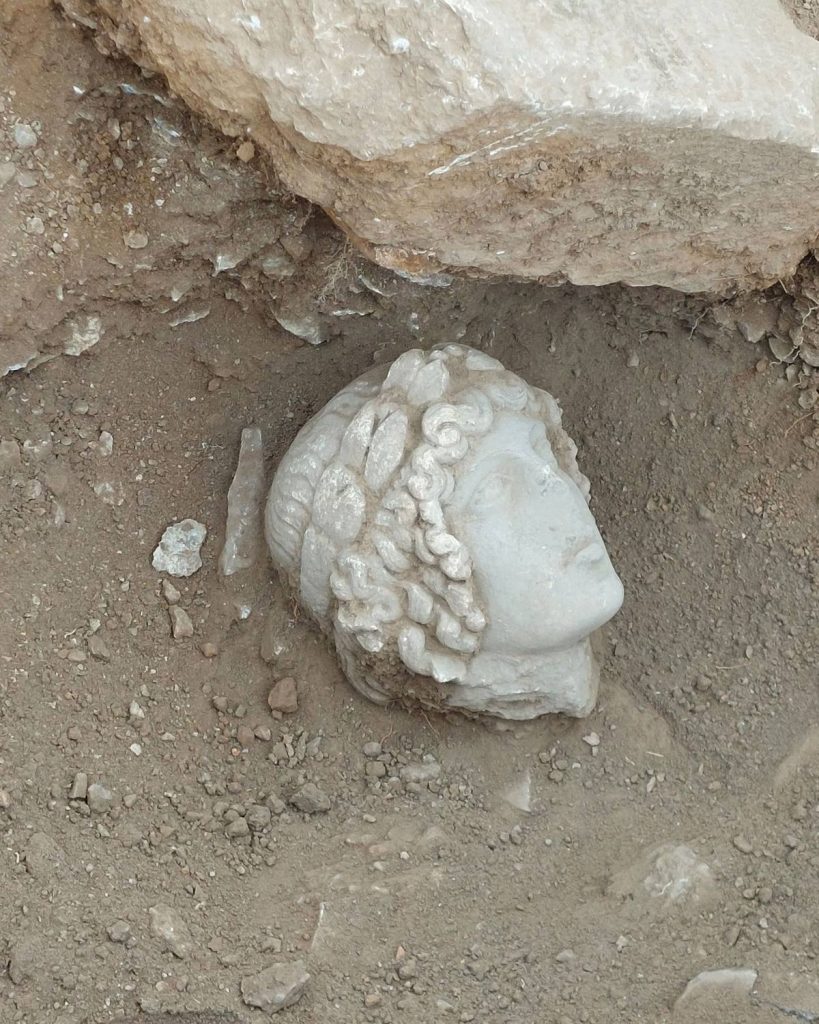Nestled in the historic landscapes of northern Greece lies Philippi, an ancient city that has once again yielded a remarkable artifact from its rich archaeological tapestry. A marble head of Apollo, carved in the 2nd or 3rd century A.D., stands as a striking testament to both the artistic brilliance of the Roman period and the enduring cultural legacy of classical art. This artifact, however, is no ordinary relic; its history spans centuries, encapsulating both the grandeur of the classical world and the practical adaptations of the medieval era. This fascinating transformation from a depiction of a revered Greek god to a decoration for a medieval fountain reveals a compelling narrative about the cultural interplay and historical continuity that define Philippi’s storied past.

A Masterpiece of Roman Craftsmanship
The Apollo sculpture’s origins lie in the Roman period, a time when the artistic ideals of classical Greece had been embraced and refined. Apollo, a figure synonymous with light, music, and prophecy, was one of the most venerated deities in Greek and Roman mythology. The skill evident in the carving of the marble head reflects the artistic dedication of Roman sculptors, who sought to immortalize their gods with lifelike precision. From the intricate details of Apollo’s flowing hair to the serene expression on his face, the sculpture embodies the Roman reverence for harmony, proportion, and beauty. In its original context, this artwork may have served as a centerpiece in a temple or a decorative element in a public or private space, symbolizing Apollo’s association with wisdom and artistic inspiration—qualities cherished by classical societies.
A Medieval Transformation: Function Meets Heritage
What elevates this discovery beyond its classical origins is the sculpture’s remarkable repurposing during the medieval era. Archaeological evidence suggests that the Apollo head was integrated into a public fountain, a practice not uncommon in the Middle Ages. This adaptation underscores the medieval inclination to reimagine classical relics for new, practical purposes. At a time when ancient ruins and sculptures were abundant in places like Philippi, such artifacts were often repurposed to meet the needs of a changing society. In its new role as a fountain decoration, the Apollo head likely became a focal point in the community, its classical artistry lending an air of timeless elegance to an everyday utility.
This transformation illustrates the dynamic relationship between historical artifacts and the societies that inherit them. By incorporating a relic of Apollo into a functional medieval setting, the people of Philippi forged a tangible connection between their classical heritage and their evolving cultural and religious identity.
A Symbol of Cultural Resilience and Continuity
The reuse of a pagan artifact in a predominantly Christian society highlights the complex cultural dynamics of Philippi during the Middle Ages. By the time this sculpture was repurposed, Christianity had firmly established itself as the dominant faith in the region, yet the artistic and cultural achievements of the classical world continued to command respect. The decision to incorporate the Apollo head into a public fountain speaks volumes about the enduring influence of classical ideals on medieval life. It suggests that even as the ideological framework of society shifted from paganism to Christianity, the aesthetic and symbolic value of classical art remained relevant.
Philippi, situated along the Via Egnatia—a major trade route of the ancient world—was a crossroads of cultural exchange. This blending of pagan and Christian elements within public spaces reflects the city’s unique role as a cultural and historical nexus. The Apollo sculpture’s dual existence as both a classical masterpiece and a medieval ornament exemplifies this intersection, symbolizing a cultural dialogue that bridged two distinct eras.
Bridging Art and History
The Apollo head’s journey through time serves as a powerful reminder of the fluid relationship between art and history. Its transformation from a classical sculpture to a medieval fountain decoration encapsulates how societies reinterpret their heritage to align with new cultural, social, and religious paradigms. This adaptive reuse is not merely an act of practicality; it is also a testament to the resilience of cultural memory. By preserving and recontextualizing an artifact like the Apollo sculpture, the residents of Philippi demonstrated a profound respect for their past while actively shaping their present.
This duality also sheds light on the ways in which ancient societies approached legacy and tradition. For the people of Philippi, honoring their classical heritage did not mean resisting change; instead, it involved integrating elements of the past into the fabric of their evolving identity. The Apollo sculpture, once a representation of divine beauty and wisdom, became a symbol of community and continuity, embodying the enduring relevance of classical ideals.
Conclusion: A Timeless Dialogue
The marble head of Apollo discovered in Philippi is more than an archaeological treasure—it is a cultural bridge that connects the classical and medieval worlds. Its repurposing as a fountain decoration highlights the ingenuity and adaptability of the medieval period, while its original craftsmanship celebrates the artistic and spiritual ideals of the Roman era. Together, these facets reveal a city deeply rooted in its history, yet unafraid to evolve.
Through this artifact, we glimpse the intricate interplay of tradition and innovation that defines human civilization. The Apollo sculpture’s dual role underscores the enduring impact of classical art on subsequent generations, serving as a reminder that the past is not merely a distant memory but an active participant in the present. As we reflect on the layers of history embedded in this artifact, we gain a deeper appreciation for the ways in which ancient societies preserved their legacy, crafting a timeless dialogue between art, culture, and history that continues to inspire us today.





